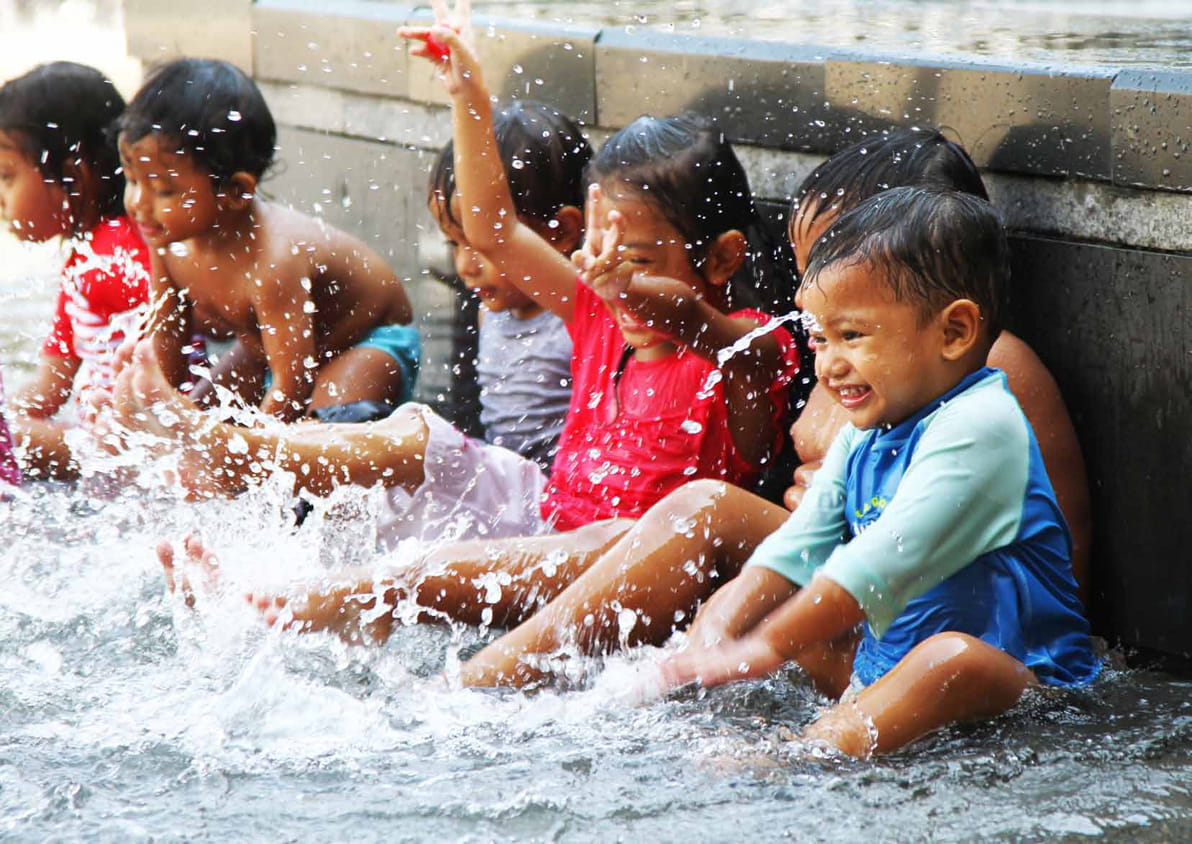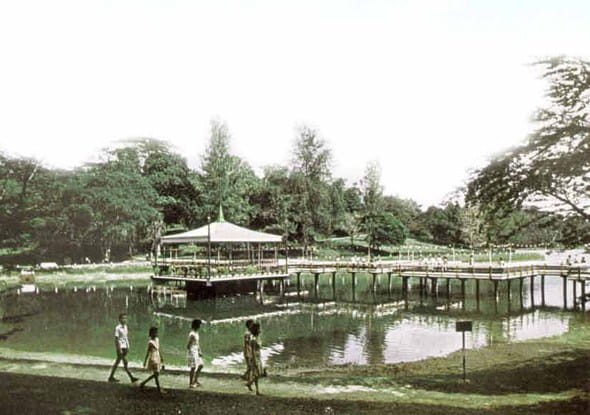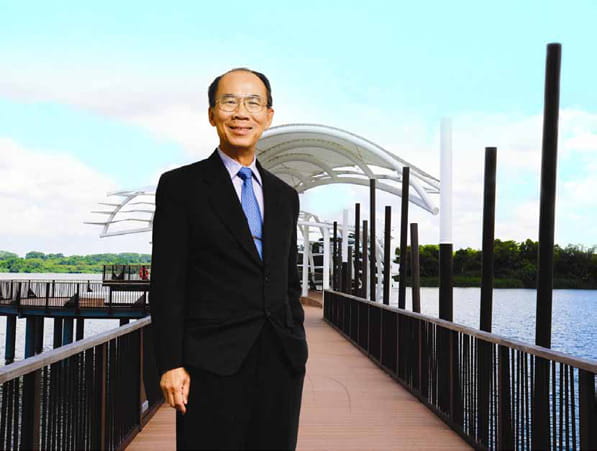Stories > Water Ways
Water Ways
 Singapore’s lack of water was its Achilles heel in early independence. It isn’t anymore, thanks to a vision for water security set over 40 years ago.
Singapore’s lack of water was its Achilles heel in early independence. It isn’t anymore, thanks to a vision for water security set over 40 years ago.
By Kim Lee
Water flows through Singapore’s story of independence like a thread of consciousness in the psyche of its people. It started with the newly independent nation’s wary dependence on Malaysia for water; struggles with severe floods and droughts; and campaigns exhorting the “water is precious” message. Then came a shift in the tone of the news. Headlines heralded the creation of new reservoirs, celebrated waterway clean-ups, introduced technological advances in desalination plants and NEWater.
Few people, however, can piece these fragments together coherently to appreciate and tell the story of Singapore’s water journey like Tan Gee Paw, Chairman of PUB, Singapore’s national water agency, for he was there when the fledgling nation began to assess its water situation. The picture that comes into focus is deep and wide, for no other country in the world has planned for water security like Singapore, according to a special report on global water outlook in the May 2010 issue of The Economist. The tale, as told by Tan, begins with an elemental observation of what water means…
EXISTENCE AND SECURITY
“Water is fundamental not just to the survival of cities or nations but to civilisations. If you look into history, civilisations have come and gone because of water,” Tan notes. “This is going to become even more so as we go into the future because of climate change.
“The world is already about 50% populated in cities, and in years to come, more so. Eventually, most cities will run out of water because of a high concentration of people and inadequate water resources in that immediate neighbourhood.
“So water security is not just an issue for water-stressed countries today, but for all countries — even those blessed with an abundance of water.”
Little had been done about water resources in Singapore after the Second World War. “When we took over and became independent from the British, it was as it was then. We only had the central reservoirs — Peirce, MacRitchie and Seletar — which were very small reservoirs.” Singapore’s population in 1965 was only 1.9 million and they used a low 350,000m3 of water per day. Today, with 5.8 million people, daily water demand is more than 1.7 million m3, and expected to double in the next 50 years.
FUTURE MAPPING
“The population was growing, so the Water Planning Unit was formed under the Prime Minister’s Office (in 1971). In city planning, every five years is a rolling plan — but you can’t do that for water. We planned for 50–100 years. So the first water masterplan looked far into the future, to the expiry of the water agreements and beyond.” The first of two water agreements with Malaysia expired in 2011.
“We mapped out where the catchments could be for future exploitation of surface run-off.
“We also looked at water re-use then. We recognised the significance of a closed loop cycle. Recycling in a closed loop cycle means the same water will go round and round. All you have to do is top up the losses, and that comes from rainfall and reservoirs. It builds in resilience. Water recycling was included in the first water masterplan, but the technology wasn’t there. We looked at seawater desalination too, but in those days the technology was basically boiling water and condensing the steam. The cost was phenomenal, just impossible! But we saw the long-term potential.”
NEW WATERS
“After the masterplan was completed, we built our first water recycling plant in the early ‘70s. We succeeded in taking sewage effluent and converting it into drinking water that met WHO standards as early as those days — but the cost was too high and the equipment kept breaking down. After collecting data for one to two years, we shut down the plant because we knew the technology had not yet arrived. We turned our attention back to catchments.
“We developed Kranji and all the western catchments, and then Bedok and all the other areas, damming rivers to create estuarine reservoirs. Then we realised that the Singapore River and Kallang Basin had to be cleaned up. The Prime Minister announced the challenge in 1977 and we cleaned it up nicely over 10 years, preparing for the day when technology could treat the water.”
TRIUMPH AT LAST
Meanwhile, wastewater treatment technology matured, and become more reliable and cheaper. In 2000, the technology for what would become NEWater was assembled.
“We built the first pilot plant, and lo and behold — it succeeded! That opened the door to water re-use in a closed loop system. It was really a great triumph.”
Today, Singapore has four NEWater plants that produce 30% of its daily water needs. The recycled water is of such high quality that it is diverted for use in industry, notably in wafer fabrication, besides other manufacturing processes and cooling towers. This frees a huge amount of drinking water.
After that came seawater desalting, the most expensive option, as it is highly-energy intensive in the reverse osmosis process it uses. Desalinated water began to flow in September 2005 from a plant in Tuas, one of Southeast Asia’s largest reverse-osmosis seawater treatment facilities. It produces 136,000 cubic metres of water a day, enough to fill 54 Olympic-sized swimming pools. An even bigger desalination plant will be ready in 2013. It will produce 318,500 cubic metres of water a day.
BLESSING AND DISGUISE
“Now we have all four taps running: first, imported water from Malaysia; the second tap, our own water catchments and rainfall; the third is NEWater; and the fourth, desalting of sea water.” Consequently, imported water began to lose significance.
“The first water agreement has expired. We didn’t need it anymore, so we let it lapse.” The second water agreement will run until 2061. “But before it expires, technology is not going to stand still. There are going to be better methods of doing things…. I foresee when the second water agreement comes up for mention in 50 years, it will be even more of a non-event. We are prepared for the day when we will no longer have the water agreements that were enshrined in our separation agreement.
“We are very fortunate in Singapore on many counts. Firstly, we are an island nation. Secondly, we are water-stressed.
“According to the UN, we rank 170 out of 190 countries for being water stressed, almost like a desert — and that is a blessing in disguise.”
“Because of that, and water rationing, the national psyche is that water is precious. Because of that, we have been able to push through difficult policies that many other countries have not. When we developed NEWater, the population could see why.”
GOVERNANCE AND TECHNOLOGY
“The first lesson in water security is water governance. We founded the Institute of Water Policy in 2008 because we saw how important it is. We developed our own water governance and policies to fit our situation of a small, multiracial island nation with a fast-growing population. Governance is the vehicle with which you implement good water policies. Then come strategic long-term plans, and from this, various water projects, water schemes and water plants. Then R&D comes in.
“In technology, we have followed others. We are extremely conservative in applying it to the production of water. We make sure it is tried, tested and proven technology. NEWater is not new technology. We brought together existing technologies, experimented with them until it worked and optimised it. There were a lot of operational problems to resolve before we finally got NEWater going.
“We have spent something like S$470 million on R&D in Singapore just on water. We give it to the universities and help with the programmes.
“There is a lot of work being done to reduce the amount of energy that membrane filtering technology consumes in the reverse osmosis process. The R&D work we funded for Siemens to do that in an installation in Punggol has brought it down by half. Beyond that, we will need breakthrough technologies.
“One of the things we are looking at is biomimicry. For example, we desalt water in our own bodies with our kidneys; mangrove trees live in seawater, and can desalt seawater to get fresh water for their consumption — no big pumps and cables are needed for that. Enzymes called aquaporins have been discovered that do the work. So, we are experimenting with these things. It’s a long shot.
“But, hopefully, we can have something — mangrove technology — 15–20 years from now! And that will really be very cost effective, hardly any energy needed.”
THE PEOPLE EXPERIMENT
“To implement an environmental and water policy successfully, we’ve got to take into consideration the level of social and economic development — that is fundamental. If you run too far ahead of it, implementation will not be successful. If you lag too far behind, you will create inefficiencies in the system. You can’t look at water policy in isolation. You must look at social policies, economic policies, where they are going, when the time will be the right to introduce the kind of water policies you want, and so on.”
By 2007, the PUB decided that Singaporeans had matured enough socially to start a new phase in their relationship with the nation’s water. The ABC — Active, Beautiful and Clean — Waters programme was unveiled. Taking water structures beyond utilitarian water collection, storage and drainage, it brings in an aesthetic dimension to these spaces for recreation and community interaction. Tan views it as a “social experiment” to bring the people back to the water to see if they could appreciate it enough to keep it clean, if they had developed a sense of stewardship towards their water.
Citizens have taken to it. There are now 20 successful ABC Waters developments. Four more will be coming in the next two years, more are being assessed for the next 15 years.
“It has been a learning journey,” reflects Tan. “Overall, I think we have done very well.”
AN ARCHITECT OF SINGAPORE’S WATER STORY
Tan Gee Paw, Chairman of Public Utilities Board, has spent his entire career improving the nation’s environment and water access. His journey began in the late ‘60s, taking him from the Prime Minister’s Office and Water Planning Unit, to the Ministry of the Environment to work on the nation’s sewage challenges, and back to PUB in 2001 for the expiry of the first water agreement.
He oversaw the development of wastewater recycling known as NEWater, and the 10-year project to clean up the Singapore River and Kallang Basin. In working to engineer a robust and sustainable water supply system, he brought international recognition to Singapore as PUB won numerous accolades, including the prestigious Stockholm Industry Water Award 2007.



